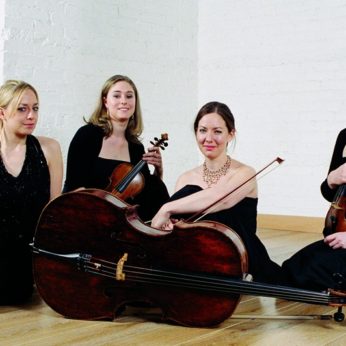Composer: Béla Bartók (b. 1881 - d. 1945)
Performance date: 05/07/2009
Venue: Bantry Library
Composition Year: 1926-7
Duration: 00:15:42
Recording Engineer: Anton Timoney, RTÉ lyric fm
Instrumentation: 2vn, va, vc
Instrumentation Category:String Quartet
Artists:
Callino Quartet (Sarah Sexton, Mihaela Girardi [violins], Rebeccca Jones [viola], Sarah McMahon [cello]) -
[quartet]

The size and musical significance of the
string quartet has changed radically ever since the 18th century
when Haydn’s quartets were pre-eminent and quartets, such as those by
Boccherini, were generally published in sets of six. Then in Beethoven’s
lifetime cycles of even two or three quartets became rarer, and this trend
culminated in his late string quartets, just one of which could stand alone and
carry the same weight as a symphony. Bartók’s six string quartets, which he
wrote between 1908 and 1939, continued the transformation of the character and
function of composition in general, and the string quartet in particular, and
his quartets occupy a central position, both in his output and in 20th
century music.
Bartók wrote his Third String Quartet
(disregarding the quartets he wrote before 1903 and which he later suppressed)
in September, 1927, by which time his style had become much more personal. So
the work is a distillation of his most distinctive stylistic traits, including
his fascination with the characteristics of the music of the many ethnic
minorities in the Hungarian section of the Austro-Hungarian Empire, which
included Slovak, Romanian, Ruthenian, Serbian, Bulgarian and Transylvanian
communities. He had collected peasant music with Kodály in the early years of
the century and believed that the music of the rural peasants was a ‘natural
phenomenon’, which had the potential to reform both the nation’s musical life
and his own musical approach. In his quartets he relied on short motifs and so
the peasant music particularly appealed to him because of its small-scale
completeness.
In the Third Quartet he achieved the
ultimate compression of his formal, pitch and rhythmic materials. The four
sections are played without a break, and the ABAB structure is the first sign
of arch form in his music. In October, 1928 it was awarded joint first prize in
a competition of the Musical Fund Society of Philadelphia, where it was first
performed on 30th December, 1928. Bartók had recently heard Berg’s Lyrische
Suite, and this partly inspired his new approach to string sonority, for
the score of the Third Quartet is full of ‘special effects’, which give the
work its startling piquancy. There are two basic formal units of contrasting
character and material: the introspective Prima parte in which the motif
undergoes extensive polyphonic development, and the strongly contrasted Seconda
parte, which features Hungarian folk dance elements, such as brilliant
glissandos, driving rhythms and pizzicatos (especially the ‘Bartók pizzicato’
in which the string is plucked so forcefully that it rebounds against the
fingerboard). The Seconda parte is followed by two minor sections, the
first of which is a shortened recapitulation of the Prima parte. The
Coda uses material from the Seconda parte, and the percussive rhythms
propel the work to a vigorous conclusion.
Copyright © 2025 West Cork Music. All rights reserved.
Designed and developed by Matrix Internet